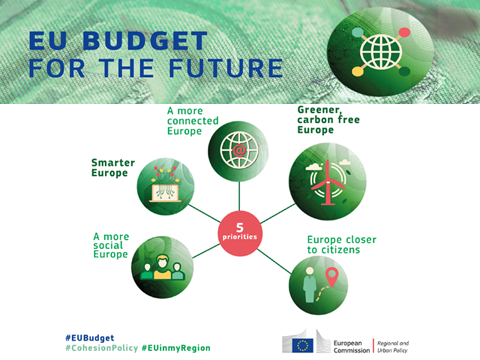For the next long-term EU budget 2021-2027, the Commission proposes to modernise Cohesion Policy, the EU's main investment policy and one of its most concrete expressions of solidarity. The main features of the Commission's proposal for a modernised Cohesion Policy are: 1. A focus on key investment priorities, where the EU is best placed to deliver: The bulk of European Regional Development Fund and Cohesion Fund investments will go towards innovation, support to small businesses, digital techno
- 08 June 2018

For the next long-term EU budget 2021-2027, the Commission proposes to modernise Cohesion Policy, the EU's main investment policy and one of its most concrete expressions of solidarity.
The main features of the Commission's proposal for a modernised Cohesion Policy are:
1. A focus on key investment priorities, where the EU is best placed to deliver: The bulk of European Regional Development Fund and Cohesion Fund investments will go towards innovation, support to small businesses, digital technologies and industrial modernisation. It will also go to the shift towards a low-carbon, circular economy and the fight against climate change, delivering on the Paris Agreement.
2. A Cohesion Policy for all regions and a more tailored approach to regional development:
- Investing in all regions: Regions still lagging behind in terms of growth or income – mostly located in the South and East of Europe – will keep benefiting from important EU support. Cohesion Policy will continue investing in all regions, as many of them across Europe – including in richer Member States – struggle to achieve industrial transition, fight unemployment and hold their own in a globalised economy;
- A tailored approach: Cohesion Policy keeps 3 categories of regions: less-developed, transition and more developed regions. To reduce disparities and help low-income and low-growth regions catch up, GDP per capita remains the predominant criterion for allocating funds. In addition, new criteria aim at better reflecting the reality on the ground – youth unemployment, low education level, climate change and the reception and integration of migrants.
- Locally-led: The 2021-2027 Cohesion Policy stands for a Europe that empowers, by supporting locally-led development strategies. Local, urban and territorial authorities will be more involved in the management of EU funds, while increased co-financing rates will improve ownership of EU-funded projects in regions and cities.
3. Fewer, clearer, shorter rules and a more flexible framework:
- Simplifying access to funds: The Commission proposes to make the rules less complex in the next long-term EU budget, with less red tape and lighter control procedures for businesses and entrepreneurs benefiting from EU support;
- A single rulebook: One set of rules now cover 7 EU funds implemented in partnership with Member States ('shared management'), which will make life easier for EU funds programme managers. It will also facilitate synergies, for example between Cohesion Policy funds and the Asylum and Migration Fund when it comes to the development of local integration strategies for migrants. The framework also allows for more efficient links with other funds from the EU budget toolbox; for example Member States can choose to transfer some of their Cohesion Policy resources to the InvestEU programme.
- Adapting to needs: The new framework also combines the stability necessary for long-term investment planning with the right level of flexibility in order to cope with unforeseen events. A mid-term review will determine if changes in the programmes are needed for the last 2 years of the funding period, and limited transfers of resources within EU funds programmes will be possible.
4. A strengthened link with the European Semester to improve the investment environment in Europe: The Commission proposes to strengthen the link between Cohesion Policy and the European Semester, to create a growth- and business-friendly environment in Europe, so that both EU and national investments can deliver their full potential. This stronger Cohesion Policy support to structural reforms will ensure full complementarity and coordination with the new, enhanced Reform Support Programme.
